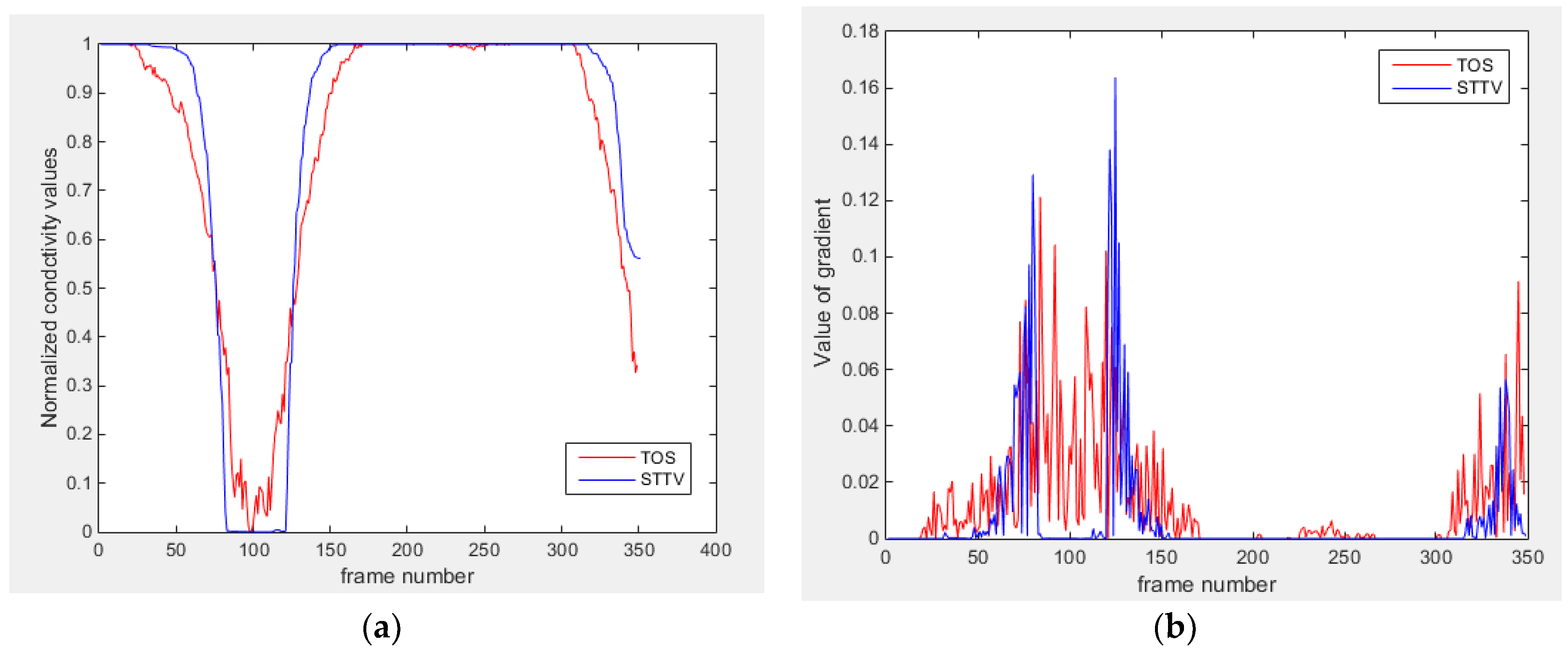Electrical resistance tomography has been investigated for few decades since it was proposed in 1984 as an approach for vivo image reconstruction to obtain the spatial distribution of the resistivity of a tissue [
1]. Many applications have benefited from the ERT technique due to its low cost, high speed and non-invasive advantages. The implementation of ERT requires a conductive domain where electrodes are required to be directly attached to its boundary. An electric field is generated from injecting the current via electrode patterns where an Alternating Current (AC) source would be required. For voltage measurement, voltmeters would be applied to electrodes simultaneously. The measurement strategy could be selected from among the neighboring method, opposite method, adaptive method, etc. [
2]. Typical ERT problems would normally begin with a forward problem, where distribution of the potential could be worked out using a simulation modeling tool. The sensitivity distribution of the whole domain could be calculated via the perturbation method [
3]. Then, the conductivity distribution could be recovered via an inverse problem solver, which is known as an algorithm to reconstruct images from measured real boundary data.
The inverse problems of electrical tomography are actually ill-posed, and regularization methods, in this case, would be very important for recovery of conductivity mapping. Methods using the strategy of least squares solution, such as, Tikhonov regularization, are quite popular. However, most algorithms would give a result with blurred edges of the object boundary, and lead to reconstruction error because Tikhonov would over-smooth the images. In the past years, another method called total variation (TV) with different TV functions, such as, [
4,
5] has been proposed. TV has attracted attention, as higher-quality images can be obtained.
According to dynamic ERT cases, most of the traditional ERT algorithms reconstruct static images using individual frames of data which assume that no correlations exist between adjacent frames, such as, Tikhonov [
6], Gauss-Newton one-step [
7], and total variation [
8] etc. However, to reconstruct images with the regularization methods that working frame by frame may not be an optimal choice, and would result in overlapping of artefact images, although only a few papers proposed methods that account for the temporal correlation effect. High temporal resolution is one of the advantages of the ERT system, and information on the correlation between individual frames should be explored to contribute to the image quality. A few types of algorithms account for the temporal correlation effects. First, Kalman filtering has been used in different tomographic techniques. For example, M. Vauhkonen first proposed the Kalman filter method (1998) to track fast changes in electrical impedance tomography (EIT) [
9]. More recent work regarding the Kalman filter in dynamic imaging fields was also proposed, for example, M. Soleimani and M. Vauhkonen [
10] used the Kalman filter for electrical capacitance tomography (ECT) and electromagnetic induction tomography (EMT), and demonstrated the Kalman filtering approach could improve the spatiotemporal resolution (2007). A. Lehikoinen et al. (2009) evaluated dynamical conductivity distribution in a porous medium using the Extended Kalman Filter [
11]. A. K. Saibaba (2014) tracked CO
2 movement with a fast Extended Kalman Filter [
12]. In addition, another algorithm known as the temporal one-step solver (TOS), which is based on the GN one-step method was proposed by A. Adler and T. Dai (2007) in [
13], and has been investigated by comparing with the Kalman filter and conventional GN one-step method which work as if there are no correlations between successive frames. More recently, Yerworth and Bayford (2013) first proposed interpolating EIT measurements because conductivity changes during frame acquisition [
14]. Gagnon, Hervé, et al. (2015) proposed comparison works to assess advantages and drawbacks of previously presented approaches using different types of data frames with three reconstruction algorithms [
15]. Chen, Bo, et al. (2018) proposed a novel spatiotemporal total variation (STTV) method for assessing the performance of 2D and 3D moving objects using both simulation and experimental results [
16]. Temporally linked algorithms such as the one shown in the above examples provide an opportunity for faster data collection and less averaging in ERT data. A smooth regularization, however, will limit the time resolution. A temporal TV with TV regularization in time can overcome this problem, providing both high speed and sharp temporal responses.
In practice, ERT could potentially be combined with a tomography-based control system. To reach the requirement of controlling the application, high-quality images from ERT would be needed, and useful information should be extracted based on these reconstructed results for the proposes of, for example, implementation of emergency operations to avoid undesirable conditions. In this paper, we are particularly interested in the temporal and spatial performance of the spatiotemporal total variation (STTV) method. By comparing it with the TOS algorithm, we want to explore spatiotemporal information along the time domain and assess the gradients and time response of both approaches. The results of this paper are based on 2D phantom experimental tests with dynamic movement of inclusion. For each set of results, STTV and TOS are employed using the same measured data set to ensure the consistency.





































































